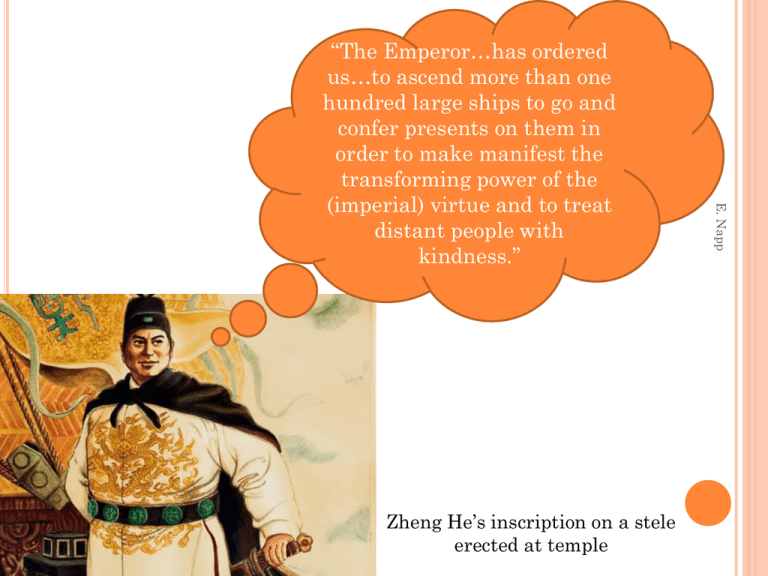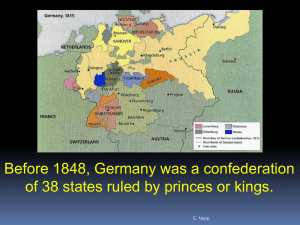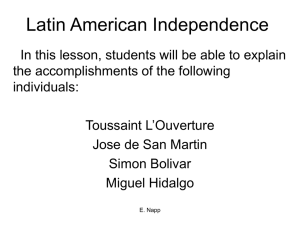Worlds of Encounter, The Fifteenth Century
advertisement

Zheng He’s inscription on a stele erected at temple E. Napp “The Emperor…has ordered us…to ascend more than one hundred large ships to go and confer presents on them in order to make manifest the transforming power of the (imperial) virtue and to treat distant people with kindness.” The fifteenth century, during which both Zheng He and Columbus undertook their momentous expeditions, proved in retrospect to mark a turning point in world history The outcome especially of the processes set in motion by Columbus’ three small ships would utterly transform the world, with enduring consequences which included the Atlantic slave trade, the decimation of the native population of the Americas, the massive growth of world population, the Industrial Revolution, and the growing prominence of Europeans on the world state But none of these developments were even remotely foreseeable in 1492 E. Napp Gatherers and hunters, agricultural villages, chiefdoms or small states, pastoral communities, and established civilizations and empires all still existed in the fifteenth century. E. Napp Among the Yoruba in West Africa, a series of city-states emerged, each within a walled town and ruled by an oba, or king (many of whom were women), who performed religious and political functions As ancient Mesopotamia or classical Greece, no single state or empire encompassed all of Yorubaland But in the nearby kingdom of Benin, a small, highly centralized territorial state emerged by the fifteenth century and was ruled by a warrior king named Ewuare Benin’s administrative chiefs replaced the heads of kinship groups as major political authorities, while the ruler sponsored extensive trading missions and patronized artists E. Napp The artists of Benin were famous for the remarkable brass sculptures they created. E. Napp The Igbo peoples rejected the kinship and statebuilding efforts of their neighbors Instead the Igbo relied on other institutions – title societies in which wealthy men received a series of prestigious ranks, women’s associations, hereditary ritual experts serving as mediators, a balance of power among kinship groups – to maintain social cohesion beyond the level of village It was a “stateless society,” famously described in Chinua Achebe’s Things Fall Apart, the most widely read novel to emerge from twentiethcentury Africa Yet the Yoruba and Igbo peoples did not live in isolated, self-contained societies rather they traded actively with distant peoples E. Napp The Yoruba and Igbo traded with the large African kingdom of Songhay far to the north. The West African kingdom of Songhay (the last in a line of kingdoms beginning with Ghana and then Mali) controlled the vital Trans-Saharan trade routes or the salt for gold routes. E. Napp But soon, all of West Africa’s diverse societies would find themselves caught up in the transatlantic slave trade In what is now New York State, the Iroquois developed a remarkable political innovation – a loose confederation among five Iroquois peoples based on an agreement known as the Great law of Peace This agreement allowed the Iroquois to settle their differences peacefully through a confederation council of clan leaders who had the authority to adjudicate disputes and set reparation payments Operating by consensus, the Iroquois League of Five Nations suppressed blood feuds and tribal conflicts E. Napp E. Napp The Iroquois League gave expression to values of limited government, social equality, and personal freedom, concepts that some colonists found highly attractive. But over the next several centuries, the lives of the Iroquois, Yoruba, and Igbo peoples as well as others would be increasingly affected by expanding economic networks and conquest empires based in Western Europe or in Russia. As the Mongol Empire disintegrated, a brief attempt to restore it occurred in the late fourteenth and early fifteenth centuries under the leadership of a Turkic warrior named Timur, known in the West as Tamerlane Timur’s army of nomads brought immense devastation yet again to Russia, Persia, and India Timur died in 1405, while preparing for an invasion of China Conflicts among successors prevented any lasting empire Timur’s conquest proved to be the last great military success of nomadic peoples from Central Asia In the centuries that followed, homelands of steppe nomads were swallowed up by Russian and Chinese empires E. Napp E. Napp Yet the majority of the world’s people lived within one of the city-centered and state-based civilizations. In China, after a century of Mongol rule and a sharply reduced population due to the plague, the Ming dynasty (1368-1644) set about restoring Chinese civilization in the fifteenth century. The Ming promoted Confucian learning based on earlier models from the Han, Tang, and Song dynasties The Ming reestablished the civil service examination system that had been neglected under Mongol rule The Ming created a highly centralized government Power was concentrated in the hands of the emperor while a cadre of eunuchs (castrated men) personally loyal to the emperor exercised great authority, much to the dismay of the official bureaucrats The state acted vigorously to repair the damage of the Mongol years by rebuilding canals and reclaiming land for cultivation E. Napp The Ming restored millions of acres to cultivation. They rebuilt canals, reservoirs, and irrigation works and planted a billion trees in an effort to reforest China. As a result, the economy rebounded, both international and domestic trade flourished, and the population grew. E. Napp China also undertook the largest and most impressive maritime expeditions the world had ever seen An enormous fleet, commissioned by Emperor Yongle, was launched in 1405, followed over the next twenty-eight years by six more such expeditions Visiting many ports in Southeast Asia, Indonesia, India, Arabia, and East Africa, these fleets, captained by the Muslim eunuch Zheng He, sought to enroll distant peoples and states in the Chinese tribute system Dozens of rulers accompanied the fleets back to China, where they presented tribute, performed the required rituals of submission, and received in return abundant gifts, titles, and trading opportunities E. Napp Officially described as “bringing order to the world,” Zheng He’s expeditions served to establish Chinese power and prestige in the Indian Ocean and to exert Chinese control over foreign trade in the region. E. Napp The Chinese, however, did not seek to conquer new territories, establish Chinese settlements, or spread their culture The most surprising feature of these voyages was how abruptly and deliberately they were ended After 1433, Chinese authorities simply stopped such expeditions and allowed this enormous and expensive fleet to deteriorate in port Part of the reason involved the death of the emperor Yongle, who had been the chief patron of the enterprise Many high-ranking officials had long seen the expeditions as a waste of resources because China, they believed, was the self-sufficient “middle kingdom,” requiring little from the outside world E. Napp E. Napp Many Chinese believed that the real danger to China came form the north, where nomadic barbarians constantly threatened. Finally, they viewed the voyages as the project of the court eunuchs, whom these officials despised. Therefore, the Chinese state deliberately turned its back on what was surely within its reach – a large-scale maritime empire in the Indian Ocean basin. At the other end of the Eurasian continent, similar processes of demographic recovery, political consolidation, cultural flowering, and overseas expansion were under way Western Europe, having escaped Mongol conquest but devastated by the plague, began to regrow its population during the second half of the fifteenth century But unlike China’s unitary and centralized government, Europe, a decidedly fragmented system of many separate, independent, and highly competitive states made for a sharply divided Christendom Many of these Western European states learned to tax their citizens more efficiently, to raise standing armies, and to create more effective administrative structures E. Napp A small Russian state centered on the city of Moscow also emerged in the fifteenth century as Mongol rule faded away. E. Napp Much of this state building was driven by the needs of war The Hundred Years’ War (1337-1454) between England and France over rival claims to territory in France A renewed cultural blossoming, known as the Renaissance celebrated and reclaimed a classical Greek tradition The Renaissance began in the commercial cities of Italy (between 1350 and 1500) -Reflected the belief of the wealthy elite that they were living in a new era removed from the religious confines of feudal Europe Humanists reflected on secular topics such as history, politics, poetry, and rhetoric E. Napp E. Napp Machiavelli’s (1469-1527) The Prince was a prescription for political success based on the way politics actually operated in a highly competitive Italy of rival city-states. The focus of Renaissance thinkers was the affairs of the world. Its secular elements challenged the otherworldliness of Christian culture, and its individualism signaled the rise of a more capitalist economy of private entrepreneurs. A new Europe was in the making, rather more different from its own recent past than Ming dynasty China from its pre-Mongol glory Initiated in 1415 by Portugal, maritime voyages sailed farther down the west coast of Africa In 1492, Columbus, funded by Spain, made his way west across the Atlantic hoping to arrive in the East and ran into the Americas In 1497, Vasco da Gama sailed around the tip of South Africa and with the help of a Muslim pilot, across the Indian Ocean to Calicut in southern India The European fleets were minuscule fleets compared to Zheng He’s hundreds of ships Motivation also differed E. Napp Europeans were seeking the wealth of Africa and Asia – gold, spices, silk, and more. Europeans were also in search of Christian converts and of possible Christian allies with whom to continue their long crusading struggle against threatening Muslim powers. E. Napp In addition, unlike China, Europe had no unified political authority with the power to order an end to its maritime outreach Europe’s system of competing states ensured the continuation of rivalry Budding European merchant communities saw opportunity for profit and monarchs viewed that revenue as a source of taxation and the seizing of overseas resources The Church saw the possibility of widespread conversion The Chinese withdrawal from the Indian Ocean facilitated European entry Europe’s agriculture expanded primarily by acquiring new lands in overseas possessions as opposed to China’s expansion toward Central Asia E. Napp The Islamic world severely fragmented since at least 900 now crystallized into four major states or empires. E. Napp The most impressive and enduring of these new states was the Ottoman Empire, which lasted in one form from the fourteenth century to the early twentieth century By the mid-fifteenth century, the Ottoman Turks had carved out a state that encompassed much of the Anatolian peninsula and had pushed deep into southeastern Europe (the Balkans), acquiring a substantial Christian population In the two centuries that followed, the Ottomans expanded into much of the Middle East, coastal North Africa, the lands surrounding the Black Sea, and even farther into Eastern Europe Only the Ming dynasty and the Incas matched the Ottomans in terms of wealth, power, and splendor E. Napp E. Napp The empire represented the emergence of the Turks as the dominant people of the Islamic world. The Ottomans seized Constantinople in 1453 and marked the demise of Christian Byzantium, allowing Ottoman rulers to see themselves as successors to the Roman Empire. In 1529, the Ottomans laid siege to Vienna in the heart of Central Europe. Many Europeans spoke fearfully of the “terror of the Turk.” In the neighboring Persian lands to the east of the Ottoman Empire, the Safavid Empire emerged in the late fifteenth and sixteenth centuries Its leadership was also Turkic but it had emerged from a Sufi religious order founded several centuries by Safi al-Din (1252-1334) The long-term significance of the Safavid Empire was its decision following 1500 to forcibly impose a Shia version of Islam as the official religion of the state Almost all of Persia’s neighbors practiced a form of Sunni Islam For a century (1534-1639), periodic military conflict erupted between the Ottoman and Safavid empires reflecting territorial rivalry and religious differences E. Napp While the Ottoman and Safavid empires brought both a new political unity and a sharp division to the heartland of Islam, two other states performed a similar role on the expanding African and Asian frontiers of the faith. E. Napp In the West African savannas, the Songhay Empire rose in the second half of the fifteenth century It was the most recent in a series of impressive states that operated at a crucial intersection of the trans-Saharan trade routes and derived much of their revenue from taxing that commerce Islam was a growing faith in Songhay but was largely limited to urban elites The fifteenth-century monarch Sonni Ali (reigned 1465-1492) gave alms and fasted during Ramadan but also enjoyed a reputation as a magician However, Songhay became a major center of Islamic learning E. Napp E. Napp The Mughal Empire in India bore similarities to Songhay, for both governed largely non-Muslim populations. Much as the Ottoman Empire initiated a new phase in the interaction of Islam and Christendom, so too did the Mughal Empire continue an ongoing encounter between Islamic and Hindu civilizations. Established in the early sixteenth century, the Mughal Empire was the creation of another Islamic Turkic group, which invaded India in 1526 The Mughals (a Persian term for Mongols) established unified control over most of the Indian peninsula, giving it a rare period of political unity and laying the foundations for subsequent British colonial rule The Ottoman, Safavid, Songhay, and Mughal empires brought to the Islamic world a greater measure of political coherence, military power, economic prosperity, and cultural brilliance than it had known in earlier centuries of Islam This new energy is sometimes called a “second flowering of Islam” E. Napp E. Napp Growing numbers of Muslim traders, many of them from India, settled in Java and Sumatra, bringing their faith with them. Unlike the Middle East and India, where Islam was established in the wake of Arab or Turkic conquest, in southeast Asia, as in West Africa, it was introduced by traveling merchants and solidified through the activities of Sufi holy men. The rise of Malacca, strategically located on the waterway between Sumatra and Malaya, became a major Muslim port city and a springboard for the spread of Islam. STRAYER QUESTIONS E. Napp What kinds of changes were transforming West African agricultural village societies and those of the Iroquois as the fifteenth century dawned? What role did Central Asian and West African pastoralists play in their respective regions? How would you define the major achievements of Ming dynasty China? What political and cultural differences stand out in the histories of fifteenth-century China and Western Europe? What similarities are apparent? In what ways did European maritime voyaging in the fifteenth century differ from that of China? What accounts for these differences? What differences can you identify among the four major empires in the Islamic world of the fifteenth and sixteenth centuries?







